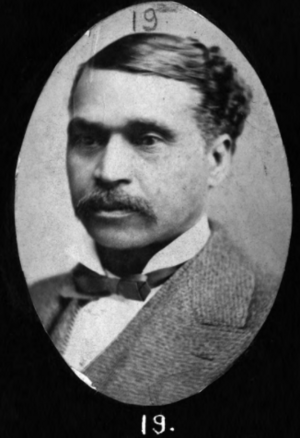James Sidney Hinton facts for kids
Quick facts for kids
Representative
James Sidney Hinton
|
|
|---|---|
 |
|
| Member of the Indiana House of Representatives from the Marion County district |
|
| In office 1881–1882 |
|
James Sidney Hinton (born December 25, 1834 – died November 6, 1892) was an important American politician and a veteran of the American Civil War. He made history as the first African American to hold a state-level job in Indiana. He was also the first African American to serve in the Indiana state legislature.
Hinton was born in Raleigh, North Carolina. His parents were "free people of color," meaning they were not enslaved. As a young person, he moved with his family to Indiana. He worked part-time as a barber while going to school. Later, he became very involved in politics with the Republican Party. During the Civil War, he became a lieutenant in the United States Colored Troops. After the war, he continued his political work. He served as a trustee for the Wabash and Erie Canal. In 1880, he was elected to the Indiana State House.
Contents
Early Life and Education
James Sidney Hinton was born in 1834. His parents, John Cooper Hinton and Hannah Mitchell Hinton, were free people of color in Raleigh, North Carolina. His father was a skilled builder who made skylights. In 1848, when James was about 14, his family moved to Terre Haute, Indiana.
In Terre Haute, Hinton started working part-time as a barber. At the same time, he attended a special school for four years. This school was a "subscription school," which meant the local African-American community paid for it. After that, he spent two years at a Quaker high school. This school was in Hartford in Vigo County.
Hinton later went to the Union Literary Institute in Union City, Indiana. This school was sometimes called the "Greenville Institute." One of his classmates was Hiram Revels. Hiram Revels also came from a free family. He later became a politician and was the first African American to be elected as a United States Senator.
In 1859, Hinton was chosen as the Grand Master of the Indiana lodge of the Prince Hall Masons. This was an important leadership role in a well-known community group.
When the American Civil War began in 1861, Hinton wanted to join the Union Army in Indiana. However, he was turned away because of his race. In 1863, the United States Army began allowing African-American volunteers to join.
Hinton then enlisted and became a lieutenant. He helped recruit soldiers for different Union regiments. These included the 54th Massachusetts Infantry Regiment, the 55th Massachusetts Infantry Regiment, and the 28th Indiana Infantry Regiment (Colored).
Moving to the Capital and Marriage
In 1862, Hinton moved to Indianapolis, which is the capital city of Indiana. He lived and worked there for the rest of his life. He started his own real estate business. While in Indianapolis, he also married Eliza J. Mitchell.
Political Career and Public Service
After the Civil War ended, James Sidney Hinton became a powerful speaker for the Republican Party. He traveled and gave speeches in many states. His political success grew because he had strong connections. These connections came from his involvement with the Methodist Episcopal Church and the Masons.
In 1872, Hinton was chosen as a delegate for the 1872 Republican National Convention. This was a big meeting where the Republican Party chose its candidate for president. He was one of only two African-American delegates at this important event.
From 1874 to 1878, Hinton served as a trustee for the Wabash and Erie Canal. This made him the first African American to hold a statewide office in Indiana.
In 1880, Hinton was elected to represent Marion County in the Indiana State House. He served one term, which is usually two years. In the next election, he was defeated in the Republican primary by Samuel A. Elbert. Samuel Elbert was also African American, but he did not win the general election. Hinton stayed active in politics even after his defeat. In 1892, he gave a speech to support the Republican campaign in Brazil, Indiana. After his speech, he collapsed and sadly passed away.
Legacy and Remembrance
James Sidney Hinton is buried in the historic Crown Hill Cemetery in Indianapolis. In 2014, a special statue of Hinton was revealed at the Indiana State Capitol. This statue, called a bust, is on the second floor. It stands next to a bust of U.S. Representative Julia Carson. Both statues are part of a permanent display that honors Black history in Indiana. The artist who created both sculptures was Jon Hair.

